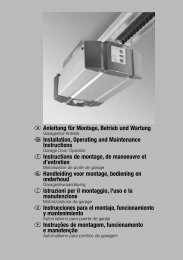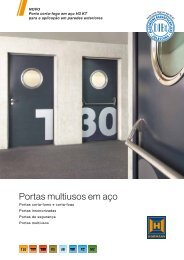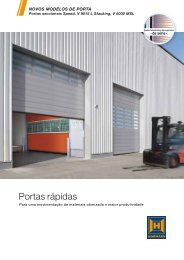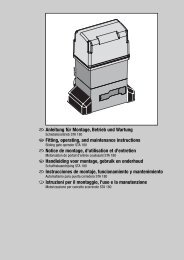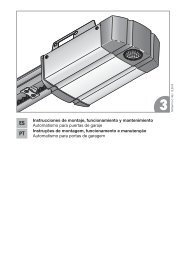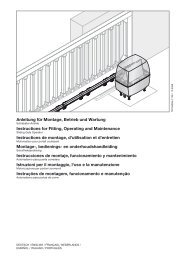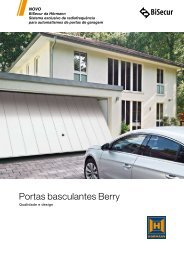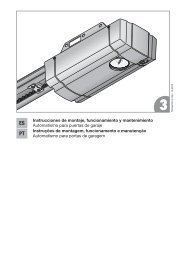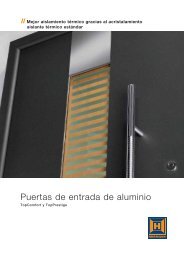Template BA B168xH238 - Hormann.be
Template BA B168xH238 - Hormann.be
Template BA B168xH238 - Hormann.be
You also want an ePaper? Increase the reach of your titles
YUMPU automatically turns print PDFs into web optimized ePapers that Google loves.
ENGLISH<br />
Setting the starting points for double-leaf systems:<br />
▶ See figure 12.8<br />
1. Set DIL switch 15 to ON.<br />
15 ON Set the desired starting points<br />
15 OFF Without function<br />
2. Press circuit board button T.<br />
First gate leaf A (traffic leaf) and then gate leaf B move<br />
normally in press-and-release operation in the OPEN<br />
direction.<br />
3. When gate leaf A passes the required position for the<br />
start of slow speed, briefly press circuit board button P.<br />
4. When gate leaf B passes the required position for the<br />
start of slow speed, briefly press circuit board button P.<br />
Both gate leaves move at slow speed for the remaining<br />
distance until in the OPEN end-of-travel position.<br />
5. Press circuit board button T.<br />
First gate leaf B and then gate leaf A move normally in<br />
press-and-release operation in the CLOSE direction.<br />
6. When gate leaf B passes the required position for the<br />
start of slow speed, briefly press circuit board button P.<br />
7. When gate leaf A passes the required position for the<br />
start of slow speed, briefly press circuit board button P.<br />
Both gate leaves move at slow speed for the remaining<br />
distance until in the CLOSE end-of-travel position.<br />
8. Set DIL switch 15 to OFF.<br />
9. The LED GN flashes to indicate that you must perform<br />
two consecutive force learning runs (see section 7.1).<br />
Note:<br />
Changing the starting points for slow speed deletes the<br />
already taught-in forces. After the changes have <strong>be</strong>en made,<br />
the LED GN flashes to signal that the forces must <strong>be</strong> taught in<br />
again.<br />
Resetting the starting points for slow speed (soft stop) to<br />
the factory setting:<br />
▶ Set DIL switch 16 to ON and then to OFF.<br />
16 ON Slow travel speed for all runs/delete slow<br />
speed starting points<br />
16 OFF Without function<br />
7.4.6 Setting the slow speed:<br />
The Speed V potentiometer can <strong>be</strong> used to set the slow<br />
speed in a range of 30-60% of the normal speed.<br />
Setting the slow speed:<br />
▶ See figure 12.8a<br />
1. Set DIL switch 4 to ON.<br />
4 ON Set-up mode<br />
4 OFF Normal mode in press-and-release<br />
operation<br />
2. Change the Speed V potentiometer as needed.<br />
Full left<br />
Centred<br />
Full right<br />
30% speed<br />
45% speed<br />
60% speed<br />
3. Set DIL switch 4 to OFF.<br />
The set value will <strong>be</strong> taken over.<br />
7.4.7 Slow travel speed<br />
If the measured force is too high when the potentiometer<br />
setting for the force limit is 0%, it can <strong>be</strong> reduced via a lower<br />
travel speed for normal and slow speed.<br />
To reduce the travel speed:<br />
1. Set DIL switch 16 to ON.<br />
16 ON Slow travel speed for all runs/delete slow<br />
speed starting points<br />
16 OFF Normal travel speed for all runs<br />
2. Perform three successive force learning runs<br />
(see section 7.1).<br />
3. Check the force again with a force measuring device.<br />
8 Radio<br />
8.1 Hand transmitter HSM 4<br />
WARNING<br />
Danger of injury during gate travel<br />
Persons may <strong>be</strong> injured by gate travel if<br />
the hand transmitter is actuated.<br />
▶ Make sure that the hand<br />
transmitters are kept away from<br />
children and can only <strong>be</strong> used by<br />
people who have <strong>be</strong>en instructed<br />
on how the remote-control gate<br />
functions!<br />
▶ If the gate has only one safety<br />
feature, only operate the hand<br />
transmitter if you are within sight of<br />
the gate!<br />
▶ Only drive or pass through remote<br />
control gate systems if the gate is in<br />
the OPEN end-of-travel position!<br />
▶ Please note that unwanted gate<br />
cycles may occur if a hand<br />
transmitter button is accidentally<br />
pressed (e.g. if stored in a pocket/<br />
handbag).<br />
Caution<br />
Danger of injuries due to unintended gate travel<br />
Unintended gate travel may occur while teaching in the<br />
radio system.<br />
▶ Pay attention that no persons or objects are in the<br />
gate's travel range when teaching in the radio system.<br />
42 TR10A078 RE / 07.2010





